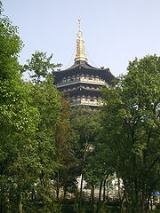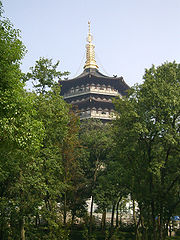
Leifeng Pagoda
Encyclopedia


Pagoda
A pagoda is the general term in the English language for a tiered tower with multiple eaves common in Nepal, India, China, Japan, Korea, Vietnam and other parts of Asia. Some pagodas are used as Taoist houses of worship. Most pagodas were built to have a religious function, most commonly Buddhist,...
is a five story tall tower with eight sides, located on Sunset Hill south of the West Lake
West Lake
Xī Hú is a famous fresh water lake located in the historic center of Hangzhou, the capital of Zhejiang province in eastern China. The lake is divided by the causeways of Sū Tí , Bái Tí , and Yánggōng Tí...
in Hangzhou
Hangzhou
Hangzhou , formerly transliterated as Hangchow, is the capital and largest city of Zhejiang Province in Eastern China. Governed as a sub-provincial city, and as of 2010, its entire administrative division or prefecture had a registered population of 8.7 million people...
. Originally constructed in the year AD 975, it collapsed in 1924 but was rebuilt in 2002, since when it has been a popular tourist attraction.
Original
The original pagoda was built in 975 AD, during Five Dynasties and Ten Kingdoms period, at the order of King Qian ChuQian Chu
Qian Chu , born Qian Hongchu , was the last King of Wuyue , a kingdom in southern-eastern China during the Five Dynasties and Ten Kingdoms period of Chinese history...
(born Qian Hongchu) of Wuyue
Wuyue
Kingdom of Wuyue , 907-978, was a small independent coastal kingdom founded during the Five Dynasties and Ten Kingdoms of Chinese history. It was ruled by the Qian family, which remains widespread in the kingdom's former territory.-Founding:...
. It was built to celebrate the birth of Qian Chu
Qian Chu
Qian Chu , born Qian Hongchu , was the last King of Wuyue , a kingdom in southern-eastern China during the Five Dynasties and Ten Kingdoms period of Chinese history...
's son, born to his Huang Fei. The Leifeng Pagoda was an octagonal, five-story structure built of brick and wood and with a base built out of bricks.
During the Ming dynasty
Ming Dynasty
The Ming Dynasty, also Empire of the Great Ming, was the ruling dynasty of China from 1368 to 1644, following the collapse of the Mongol-led Yuan Dynasty. The Ming, "one of the greatest eras of orderly government and social stability in human history", was the last dynasty in China ruled by ethnic...
, Japanese pirates
Wokou
Wokou , which literally translates as "Japanese pirates" in English, were pirates of varying origins who raided the coastlines of China and Korea from the 13th century onwards...
attacked Hangzhou. Suspecting the pagoda contained weapons, they burned its wooden elements, leaving only the brick skeleton, as can be seen from Ming paintings of the West Lake.
Leifeng Pagoda was one of the ten sights of the West Lake because of the Legend of the White Snake
Madame White Snake
The Legend of the White Snake, also known as Madame White Snake, is a Chinese legend, which existed as oral traditions before any written compilation...
.
Later, due to a superstition that bricks from the tower could repel illness or prevent miscarriage, many people stole bricks from the tower to grind into powder. On the afternoon of September 25, 1924, the pagoda finally collapsed due to disrepair.
As for whether there was a mausoleum
Mausoleum
A mausoleum is an external free-standing building constructed as a monument enclosing the interment space or burial chamber of a deceased person or persons. A monument without the interment is a cenotaph. A mausoleum may be considered a type of tomb or the tomb may be considered to be within the...
below, this was debated for years until finally radar was used to investigate. On March 11, 2001 the mausoleum was excavated and many treasures were found, most notably a gold and silver coated hair of the Buddha.
Reconstruction
In October 1999, the provincial and municipal governments decided to rebuild Leifeng Pagoda over the ruins of the old one. The new pagoda opened on 25 October 2002. It is composed of a 1400 tonne steel structure with 200 tonnes of copper parts. It contains four sightseeing elevators, and modern features including air conditioners, televisions and speakers. At the entrance of the pagoda there are two autonomous escalators to carry visitors to the pagoda's foot.The original base of the pagoda is kept in good condition as well as the treasures discovered in an underground chamber.
External links
- http://www.hz-west-lake.cn/
- http://www.visithangzhou.com/cmarter.asp?doc=1105
- http://www.chinadaily.com.cn/english/doc/2003-10/13/content_336626.htm
- http://www.seeraa.com/china-attractions/leifeng-pagoda.html

